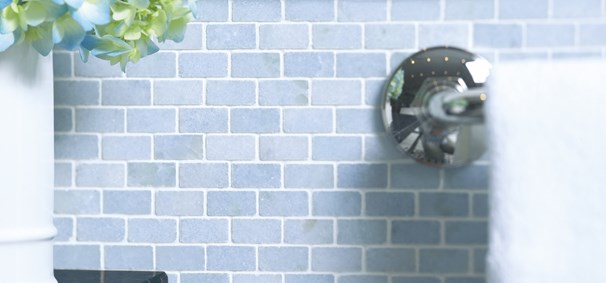
About Tile
Without going too deep, here’s a basic grounding in history and terms.
A Brief History of Tile
Decorative and functional tile has been a fixture of human life since the Ishtar Gate opened in ancient Babylon, Recently, however, formica and vinyl ruled modern design. Then, in 1981, came a colored tile renaissance, with the need to match rugs, fabrics and even bath fixtures in one seamless design.
- Types of Tile
- Ceramic
- Firing the human mind for centuries, ceramic art tile has mirrored every major design movement up to this day.
- Glass
- A category first created and then redefined by ANN SACKS. Glass allows you to play with color and light in ways no other material can.
- Leather, Wood & Concrete
- Through rich, organic, handcrafted materials, these collections offer a diverse assortment of creative forms, unique textures and tactile surfaces.
- Metal
- Metal fuses an industrial, modern feel with an incredible sense of craftsmanship, achieving a level of personalization other products can’t touch.
- Porcelain
- Durable, practical and more attractive than ever, porcelain is a versatile element of residential and commercial design. Eco-friendly, sophisticated or dramatic, it’s always performance driven.
- Terra Cotta
- Warmth, simplicity and timeless beauty are the defining qualities of terra cotta. An ideal backdrop for everything from formal antiques to modern furniture.
- Ceramic

A Natural History of Stone
For millennia, humankind has chosen stone to decorate and safeguard our religious, political, residential, and commercial architecture. Stone is quarried as blocks, then cut into slabs, often by hand. Stone tile as such is fairly new, made available for mass production in just the last 50 years. Historically, only royalty could afford it.
- Types of Stone
- Limestone
- Limestone is sedimentary—formed by the interaction of sediment deposits and shells with geological activity. Its characteristic colors include neutrals, off-white, beige, tan, taupe, and light blue-grey. Limestone finishes are usually honed and typically do not hold a high-gloss polish.
- Marble
- Marble is metamorphic—created when heat and great pressure are applied to limestone. Its characteristics include a huge variety and mixture of colors. The veins found in marble are created by mineral deposits and geologic activity. Marble can take a high polish due to its hard surface.
- Travertine
- A banded, compact variation of limestone. Its characteristic colors include neutrals, off white, beige, tan, and yellow. The look of travertine is created by the interaction of gas, shells and water with geological activity. Travertine finishes are usually honed, but some will hold a polish.
- Limestone
- Types of Finishes for Stone
- Polished
- A glossy, highly reflective finish that brings out the full color and geologic character of stone. Crystalline stones like marble and granite take polish best.
- Honed
- A form of polishing used for a satin-smooth surface with little or no gloss. Best for non-crystalline stone like limestone and travertine, it’s recommended for commercial floors.
- Textured
- A weathered, aging finish with a rustic look. Created when stone is tumbled with sand, pebbles or steel bearings.
- Bush Hammered
- Bush hammered finishes are beaten with a hammer whose face is cut in points to create a rough surface texture that varies from subtle to rough.
- Polished








